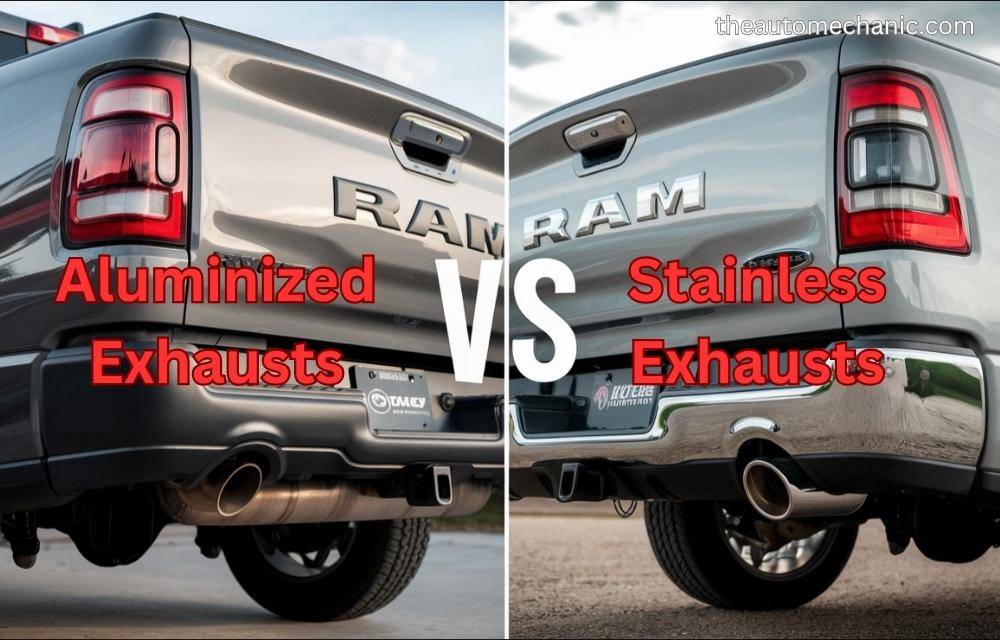Are you looking to purchase a new exhaust manifold? If yes, you might face a dilemma concerning aluminized vs. stainless exhausts. This article will clear your doubts.
“The exhaust you buy eventually will depend on where you live and how you drive your vehicle”.
If your climate is dry, an aluminized exhaust system makes perfect sense. In contrast, a stainless steel exhaust resists corrosion and minimizes exhaust repairs and replacements. It suits everyone, especially those living in rainy and snowy places. Keep reading our guide below for more tips on buying an exhaust.
Aluminized vs stainless exhausts – The differences
How are aluminized steel and stainless steel exhausts different? Learn how to do next.
Manufacturing process
Aluminized steel refers to mild steel with an aluminum coat. Some manufacturers protect aluminized steel with heatproof paint to enhance its quality. Standard steel undergoes a galvanizing process that coats it with aluminum-silicon alloy. Producers of aluminized steel put this mild steel in a molten bath containing several alloyed metals. The molten bath temperatures reach up to 450 degrees Celcius.
Aluminum silicon alloy forms a sturdy chemical bond with mild steel. The resulting aluminized steel can resist water and other corrosive agents. At the same time, it can dissipate more heat than other galvanized steel metals. Besides this coating process, aluminized steel costs less and weighs less than stainless steel. If you purchase an aluminized steel exhaust for a diesel vehicle, it might last longer than if you get it for a gasoline car.
A stainless steel exhaust is better for someone who uses their car often. It is hard-wearing and durable. Stainless steel is typically an iron metal with some degree of chromium. Some stainless steel grades have metal alloys like nickel, aluminum, copper nitrogen, silicate, and titanium. That is why we have several stainless steel grades.
Some stainless steel grades produce better exhausts than others, but those with more chromium content resist corrosion more effectively. The most common stainless steel grades are 409 and 304. Manifold manufacturers use the 409 stainless steel to make the parts that get very hot. On the other hand, the 304 Grade is perfect for areas that receive moderate heat, including the muffler and exhaust tips.
Cost
When considering aluminized vs stainless, you must focus on the cost. As stainless exhaust is more durable and heavy-duty, it costs more money. So, when upgrading to stainless steel from an aluminized steel manifold, you might pay around five hundred dollars more. It is worth upgrading if you can afford it and your driving style is rough. There is no need to upgrade if an aluminized exhaust system can last longer in your area’s weather conditions.
Durability
Aluminized steel is lighter and less durable. A vibrant aluminum muffler can be used for 5 to 8 years. The aluminum coat prevents rusting. However, if your area rains a lot, an aluminized exhaust may not get hot enough to evaporate all moisture, so the inside of the system might rust. Those living in arid climates can use it for eight years.
On the other hand, a stainless steel exhaust pipe can last ten years, depending on how you drive. It consists of alloys of metals that make it rust-resistant. A 409-grade stainless steel exhaust pipe can rust on the surface, though, as it is of lower quality than the 304-grade stainless steel exhaust Pipe. But no one can notice this rust, and you can wipe it with a rag. If your area rains and snows a lot, it will be worth investing in the durable stainless exhaust.
Heat conductivity
Aluminized vs stainless exhaust, which conducts heat well? A stainless steel metal has a lower thermal conductivity than aluminized steel. When heated to a high temperature level, it may change more. Aluminized steel may conduct heat better because of its electrostatic coat. So, many manufacturers use it to make exhausts and air conditioning systems. It has more industrial applications.
Appearance
The most attractive metal is stainless steel. It has three grades, and all have rust-resistance abilities. Aluminized steel is less attractive yet has many industrial applications than stainless steel. So, stainless steel exhaust parts have better aesthetics than aluminized muffler parts. Since an exhaust manifold is under the vehicle, and no one can see it entirely, manufacturers still use aluminized steel to make it.
SEE MORE: C5 Or C6: Which Corvette Engine is Worth Buying for You
Should I choose stainless steel or aluminized exhaust?
It all comes down to your personal needs. When selecting the best between the two, focus on the budget. We have noted that a stainless exhaust is more expensive but lasts longer. Also, we have noted that your climatic conditions largely affect your choice between the two exhausts. So, choose an aluminized exhaust if:
- You want to keep your vehicle for under five years
- You have no adequate funds to purchase the more expensive stainless steel muffler
- You live in an arid area where moisture can evaporate quickly, preventing your aluminized steel from rusting.
Select a 4-inch stainless steel exhaust if:
- You want to drive a car for over five years as this is long-lasting. If you do not want to resell your car soon, you can purchase the stainless muffler, no matter the high price.
- You can live anywhere on earth because stainless steel does not rust due to salty or moist conditions.
- You can afford it and want to drive your vehicle for a long time without considering replacing the muffler.
Does where you drive your car matter?
When selecting aluminized or stainless steel, consider your driving style.
“Both products offer the same performance advantages but their longevity is different. How long your exhaust lives will largely depend on how you use your care and on what terrains you drive it.”
If you do a lot of off-road driving and towing and your area is wet, your aluminized exhaust might rust sooner than two years. In contrast, some who drive their vehicle on tarmac roads less often might have a new-looking aluminized muffler for a long time. Stainless steel can last longer no matter how often and where you choose to drive.
READ NEXT: How to Clean K&N Air Filter
Conclusion
After discussing aluminized vs stainless exhaust here, we hope we have helped you make the best choice. You can select the best choice depending on where you live, how you drive your car, and your financial ability. If your area is dry, aluminized steel will cost less and last longer. If your area rains and snows more, you need a stainless exhaust as it can tolerate salty and humid conditions.

Bruce William is a professional content writer and vehicle engineer with extensive car maintenance and repair knowledge. His expertise spans all vehicle parts, offering practical solutions for various automotive issues. Bruce provides valuable insights through his website articles to help readers maintain their cars for optimal performance and longevity.

